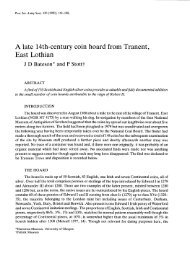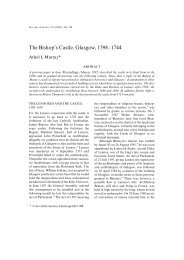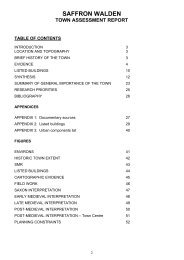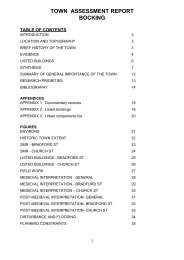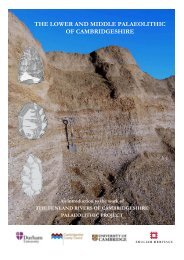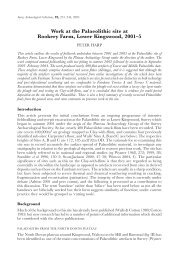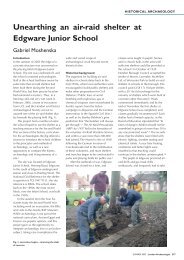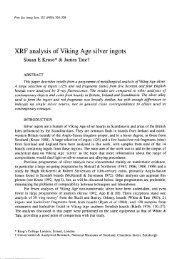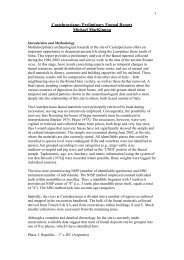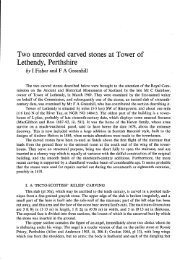The late Iron Age and Roman settlement at Leda Cottages, Westwell ...
The late Iron Age and Roman settlement at Leda Cottages, Westwell ...
The late Iron Age and Roman settlement at Leda Cottages, Westwell ...
You also want an ePaper? Increase the reach of your titles
YUMPU automatically turns print PDFs into web optimized ePapers that Google loves.
CTRL Integr<strong>at</strong>ed Site Report Series <strong>Leda</strong> <strong>Cottages</strong>, <strong>Westwell</strong><br />
Metalworking still appears to be one of the main activities of the site, as shown by the<br />
large amount of slag <strong>and</strong> fired clay found in the fills of many fe<strong>at</strong>ures. <strong>The</strong> percentage of<br />
ironworking debris from early <strong>Roman</strong> fe<strong>at</strong>ures represents 33.9% of the overall total of<br />
metalworking waste from the site (against 39.7% from furnaces <strong>and</strong> associ<strong>at</strong>ed fe<strong>at</strong>ures <strong>and</strong><br />
19.5% from fe<strong>at</strong>ures of the previous phase). <strong>The</strong> paucity of metal artefacts from the site (5<br />
nails were found in total) indic<strong>at</strong>es th<strong>at</strong> <strong>Leda</strong> <strong>Cottages</strong> was an ironworking producer site<br />
r<strong>at</strong>her than a consumer. <strong>The</strong> pottery supplied to the site includes a large majority of local<br />
grog-tempered wares <strong>and</strong> a very low percentage of Continental imports. <strong>The</strong> vessel types<br />
include a significant majority of jars, cooking pots <strong>and</strong> liquid containers r<strong>at</strong>her than open<br />
forms <strong>and</strong> beakers. <strong>The</strong>se characteristics imply a very low st<strong>at</strong>us community.<br />
<strong>The</strong> evidence presented above points to a small iron-producing site probably under the<br />
control of higher authority. It is possible th<strong>at</strong> <strong>Leda</strong> <strong>Cottages</strong> depended directly upon the much<br />
larger centre of Westhawk Farm, loc<strong>at</strong>ed only 7 km away from the site. It is difficult however<br />
to identify if iron production represented the primary economic activity of the site or a<br />
complementary one. <strong>The</strong> amount of metalworking debris from the site <strong>and</strong> the lack of other<br />
artefactual <strong>and</strong> environmental evidence seem to support this theory. However the paucity of<br />
evidence for other activities could merely be a result of the low st<strong>at</strong>us of the site <strong>and</strong> of the<br />
low level of preserv<strong>at</strong>ion (because of the acidic n<strong>at</strong>ure of the soil). <strong>The</strong> domestic element is<br />
made hard to assess because of the lack of coherent sp<strong>at</strong>ial distribution (of postholes <strong>and</strong><br />
stakeholes in particular) <strong>and</strong> difficulty in interpreting some of the fe<strong>at</strong>ures' functions. Despite<br />
research for comparisons, no parallels could be found for structures such as 8646 <strong>and</strong> their<br />
role or importance on the site remains obscure.<br />
4.3.3 Middle <strong>Roman</strong> (AD 150 to AD 270)<br />
<strong>The</strong> enclosure system<br />
<strong>The</strong> northern enclosure represented the main focus of occup<strong>at</strong>ion during the middle <strong>Roman</strong><br />
phase (Fig. 7). <strong>The</strong> enclosure ditch was re-cut (8625 <strong>and</strong> 8640), obliter<strong>at</strong>ing most of the<br />
original ditches. Ditch 8625 was aligned NW-SE for 28.5 m, turning NE-SW for 14 m <strong>and</strong><br />
ending in a rounded terminus. <strong>The</strong> NE-SW section was prolonged by another 11.5 m long<br />
segment. <strong>The</strong> terminus of this last segment bounded one side of the entrance way to the<br />
enclosure. Its profile was a V-shape with fl<strong>at</strong> or slightly concave base, a width of between<br />
0.55 <strong>and</strong> 0.75 m <strong>and</strong> a depth of 0.23 m. Ditch 8625 produced a small assemblage of 50 sherds<br />
(278 g) of pottery, d<strong>at</strong>ing the re-cut to around AD 150.<br />
Ditch 8640 was a re-cut through part of the boundary ditch 8627 (section 910, Fig. 7),<br />
with a full extent of c 26.5 m, shallow gradually sloping sides <strong>and</strong> a fl<strong>at</strong> base. Its typical width<br />
was 0.80 m <strong>and</strong> its depth was only 0.10 m. This ditch appears to be the <strong>l<strong>at</strong>e</strong>st in a series of<br />
13






